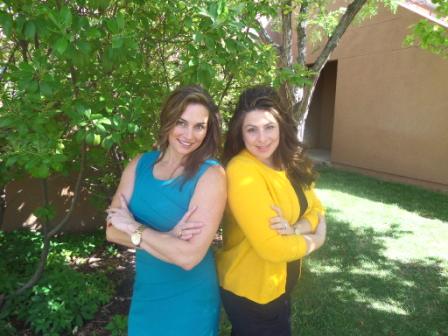
By Teri Pierce

AMBER
MACIAS-MAYO and Laura Castille are law students at the University of
New Mexico who never set out to be animal activists. “We don’t want
people to think we’re nuts!” Macias-Mayo says. Nonetheless, they may end
up transforming the lives of countless animals in New Mexico.
Before they decided to make midlife career changes, Macias-Mayo was a
paralegal in family law, and Castille was a high school principal. They
met in their first year of law school and immediately bonded over their
similarities—both married with children and tackling the challenges of
law school as older adults. They didn’t necessarily share a love of
animals, though Macias- Mayo admits to taking carrots on her walks for
any rabbits she encounters, and has had two beloved Boxers and a guinea
pig named Stanley. Castille counts among her family members a bunny and
two rescue Labs.
When they were signing up for a mandatory seminar on legal writing,
both chose children’s law. Inexplicably, the class was canceled after
the first couple of weeks, and the women were left adrift. Professor
Marsha Baum agreed to let them join her animal law seminar.
Since they were joining so late, they had to scramble to find projects to engage them in the weeks to come. Macias-Mayo happened upon information about “the deadly link,” the established relationship between animal abuse and domestic violence (“Casting Light on the Dark Side of the Human- Animal Bond”), which dovetailed perfectly with her background in family law.
Castille was an extern with state appellate court judge Monica Zamora, who suggested that she look into the idea of establishing a specialty court to deal with offenses against animals, much like the existing Drug Court or DWI court. The defining feature of a specialty court is that all the participants—from the judge to the prosecutors and defense attorneys—are well-schooled in the offending behavior and innovative ways to prevent it, so that specialized therapy can be prescribed to address the unique characteristics of each offender.
In fact, a model of therapy for animal abusers already existed, which is where the two students’ projects intersected. The AniCare Model of Treatment for Animal Abuse was developed by professional psychologists in 1999 specifically to serve the growing number of states in which judges can order specialized counseling for animal abusers. The AniCare Approach is based on evidence documenting a “deadly link” between violence toward animals and humans—the topic of Macias-Mayo’s paper.
Castille discovered through a public records request that Albuquerque Animal Welfare took about 36,000 complaint calls in 2013 for a wide range of concerns. She took a random sampling of the calls for “aggressive dog at large” and cross-checked them to see if the person charged had also been charged with other crimes. She found clear evidence of “the link”: In all but one case, the offender had been charged with other crimes, often entailing violence toward others. Yet not one case had resulted in fines or jail time for the animal offenses, which had all been dismissed.
Castille says her research supports the wide body of evidence that animal abuse is not a prelude to other, more serious crimes; it is part of an overall pattern of anti-social community-based violence. Is it possible that counseling or treatment could help these perpetrators, and thus prevent future abuse of family members and pets, and danger to the community at large?
As it happens, just such a specialty court has been established in the city of Tucson, Ariz.—the first of its kind in the country. Castille and Macias-Mayo ended up traveling to Tucson to observe the court, presided over once a week by Pima County Justice of the Peace Maria Felix since early 2013.
The court does not hear violations of leash and license laws, only citations of animal neglect and cruelty. Initially scheduled for once a month, the caseload grew rapidly, according to the judge, as animal control officers and prosecutors saw that the court was going to take such cases seriously, Macias-Mayo relates.
The two came back to Albuquerque impressed by what they saw. Professor Baum suggested that they present their findings to the New Mexico Bar, and an announcement of their luncheon talk in the Bar Bulletin was seen by Chief Judge Julie Altwies of the Bernalillo Metropolitan Court in Albuquerque. Judge Altwies summoned the two law students to her chambers to hear their proposal.
Nonplussed, they haltingly explained that they did not have a proposal, just a law school writing project. Nevertheless, they warmed to their topic, and Judge Altweis asked the two to help put together a panel of professionals who could serve on a task force to determine how best to implement an animal welfare court in Albuquerque.
“The coercive nature of the courts is powerful,” she told them. “These are not people who will seek out help or treatment on their own.”
The students learned that a state “Animal Abuse Court” had been proposed in the 2013 legislative session, but did not get far, apparently for fiscal reasons. Judge Altweis seemed confident, the women said, that such a court could be started now without additional funding, since there is an infrastructure in place for specialized tribunals.
Although they shy away from calling themselves animal advocates, Amber Macias-Mayo and Laura Castille may have set in motion a powerful mechanism for helping to prevent future cases of violence against both animals and humans. Neither of them can really explain it, though both declare it “amazing.”
“I think the difference was in finding the court in Tucson, and how well it was working—the proposal was no longer about what might be, but what actually existed somewhere else successfully,” Macias-Mayo explained. The sociological evidence was there, the therapeutic model existed, and courts have made a start—it will just take a spark at the right time to start a glow of compassionate justice. And the role of these two moms in providing the catalyst? Well, it could be the start of a beautiful alliance.
Teri Pierce headed the employment litigation department of a large Chicago law firm until she changed her life and moved to New Mexico. She practices civil rights defense, teaches yoga, fosters animals for Animal Humane, hikes with her human companion, and snuggles with her canine companion, Murphy.
